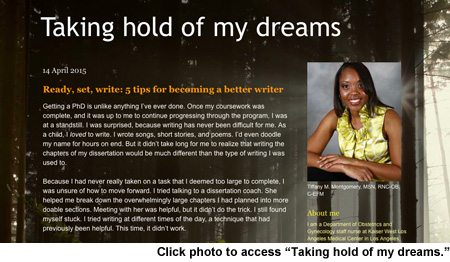Nurses speak out about gender pay gap
14The Greek philosopher Heraclitus’ doctrine that everything changes and nothing stands still doesn’t seem the case when it comes to equal gender pay in nursing, a profession where men have steadily out-earned women since 1988. In fact, nurse researchers report in the March 24/31 Journal of the American Medical Association that there has been no narrowing of the gender pay gap across settings, specialties and job titles for about a quarter century.
This isn’t the first paper to document higher salaries for male RNs, but it does offer a previously unstudied view of the pay gap, according to lead author Ulrike Muench, PhD, RN, of the University of California, San Francisco. “There have only been a couple of studies that have looked at gender earning differences in nursing,” Muench said. “They were conducted over 10 years ago and didn’t examine data over time. Our study is the first to examine a trend over time, and our goal was to include more [updated]data.”
The study reflects data from nearly 88,000 RNs from the National Sample Survey of Registered Nurses from 1988 to 2008, as well as 205,825 RNs from the 2001-2013 American Community Surveys. Men represented 7% of both data sets. Both samples showed male RNs’ salaries were higher than female RNs’ salaries every year.
While researchers estimated the overall adjusted earnings difference was $5,148, they found larger and smaller gaps in different settings. The salary gap dropped to $3,873 for RNs working in hospitals, but rose to $7,678 in ambulatory care. Pay gaps varied among the seven specialties studied: cardiology, psychiatry, neurology, pediatrics, med/surg, orthopedics and chronic care. The gap was biggest in cardiology, at $6,034.
“It is important to remember that our study didn’t capture all clinical specialties that nurses work in, such as immunology, gynecology or infectious diseases,” Muench said. “This is for two reasons: The surveys didn’t include all specialties in every survey year …. Other specialties, such as gynecology, had too few men to be included as a separate specialty.”
Largest gap
Gender pay gaps also varied by position, with nurse anesthetists standing out with a gender pay gap of $17,290.The fact that nurse anesthesia is the highest paid nursing specialty and attracts more men than any other area in nursing offers no explanation as to why there is such a significant pay gap between male and female CRNAs, according to Sharon Pearce, CRNA, MSN, president, American Association of Nurse Anesthetists.
“From a practice standpoint, all nurse anesthetists — male and female alike — receive the same education and training, and they all provide the same safe, high-quality patient care for every type of procedure requiring anesthesia,” Pearce said. “The AANA and the profession, as a whole, would like to see this gap eliminated, because there’s no acceptable reason for there to be such imbalance in the pay scales.”
The gender pay gap, while it’s making headlines in nursing, is relatively narrow compared with other professions. For example, women who are financial advisers make only 61% of what their male colleagues make, according to Ariane Hegewisch, a study director at the Institute for Women’s Policy Research, Washington, D.C.
Nurses, on the other hand make 90% of what their male counterparts make, according to IWPR’s calculations based on the U.S. Bureau of Labor Statistics Current Population Survey. IWPR published its fact sheet “The Gender Wage Gap by Occupation 2014 and by Race and Ethnicity” in April 2015. “But it is nevertheless quite shocking that [nursing]does have a gap, given that hospitals often are either in the public sector or are more likely to be unionized,” Hegewisch said. “Typically, there is greater transparency in the way people are appointed and the ways they are paid and promoted.”
What’s causing the gap?
So, why the lag in female nurses’ pay? “Practice pattern differences, career choices and educational differences explain most, if not all, of the gender gap in nursing,” said Linda H. Aiken, PhD, RN, FAAN, FRCN, professor in nursing and sociology and director of the Center for Health Outcomes and Policy Research, University of Pennsylvania in Philadelphia, who has studied the nursing workforce in the U.S. and other countries.“Men work more hours, which is an important factor since a large share of nurses are paid on an hourly basis,” said Aiken, who was not involved in this study. “They are more likely to practice in geographic areas with higher compensation, including the two coasts and large cities. They are more likely to select highly compensated clinical specialties …. Men are more likely to have a bachelor’s degree or higher, and education is associated with compensation.” Research on male and female nurses suggests that male nurses tend to move up the career ladder faster than female nurses, according to Hegewisch. This phenomenon is referred to as the glass escalator, according to a May 21, 2012, article on Forbes.com. Women climb the ladder in a female-dominated profession, like nursing, while men glide to the top on an invisible escalator.
Caren Goldberg, PhD, an assistant professor of management at American University said in the Forbes article that part of that phenomenon occurs because women are more likely to experience career interruptions, including taking time off to care for children or elderly parents.
Closing the gap
Aiken said there are solutions that would help narrow any gender gap in nurse compensation, including realigning Medicare, Medicaid and private insurance payment policies to fairly compensate nursing care across settings and specialties. “Nurse practitioners still get only 85% of the payment that MDs receive for exactly the same services, and primary care providers are compensated less than in rapidly growing clinical specialties such as nurse anesthesia,” Aiken said. “Payment policies for long-term care including mental health services require nurses to sacrifice their incomes to provide much needed care.”Hegewisch suggests nurses start a discussion about pay — that is, if they can talk about salaries. “Nationally, 60% of private sector workers say they are either prohibited by contract or strongly discouraged by their management from discussing salaries,” Hegewisch said.
Nurses can go to websites, such as Glassdoor.com or Monster.com, to share and compare salaries, according to Hegewisch. They also can talk among their peers; then, decide whether to approach management about any gaps in pay. “Be proactive,” she said.
Hegewisch said research has shown men are more likely than women to hustle for pay increases, and when women do negotiate, they may be perceived less positively than when men negotiate.
More research is needed to study possible explanations for gender pay gaps in nursing, Muench said. In the meantime, employers can introduce open-pay policies that increase transparency in compensation. For example, the U.S. Department of Labor offers “An Employer’s Guide to Equal Pay,” which includes useful tips on addressing questions about pay discrepancies.
Pearce said the AANA will be looking closely at the research from various sources and considering strategies for educating its members and their employers to ensure that all CRNAs are being compensated equitably.
“I am hoping that our study can raise awareness on this issue and that nurse employers will use our results to examine their pay data to see if differences in earnings exist in their organizations,” Muench said. “If not, then this is a great outcome; if yes, employers can assess if there are legitimate reasons for paying men more than women.”
Lisette Hilton is a freelance writer.


 I
began to feel that the only way to conquer this formidable task was to
take lessons I had learned from overcoming other obstacles and apply
them to my writing. The problem was, I didn’t have a plethora of
previously conquered obstacles to choose from. Until then, I had led a
pretty safe life, taking on only those things I knew I could achieve.
So, as a way to train for writing, I started to think of a new,
self-inflicted obstacle I could overcome. It didn’t take long before I
decided that running would be that obstacle.
I
began to feel that the only way to conquer this formidable task was to
take lessons I had learned from overcoming other obstacles and apply
them to my writing. The problem was, I didn’t have a plethora of
previously conquered obstacles to choose from. Until then, I had led a
pretty safe life, taking on only those things I knew I could achieve.
So, as a way to train for writing, I started to think of a new,
self-inflicted obstacle I could overcome. It didn’t take long before I
decided that running would be that obstacle.